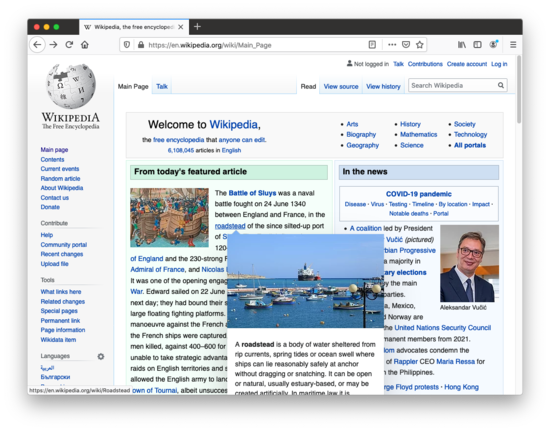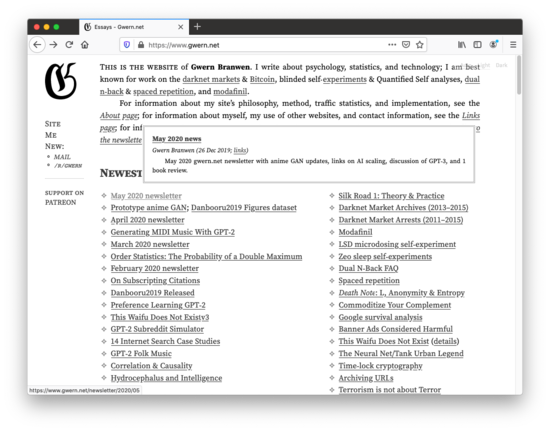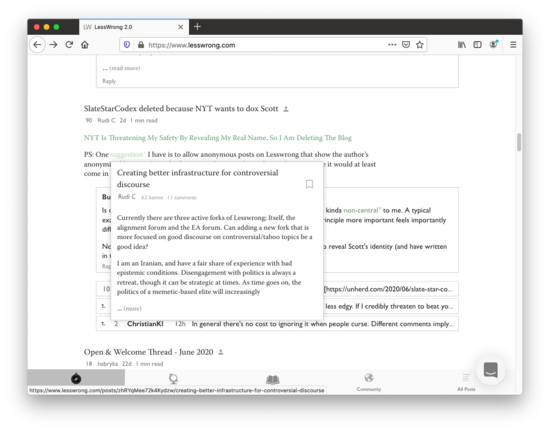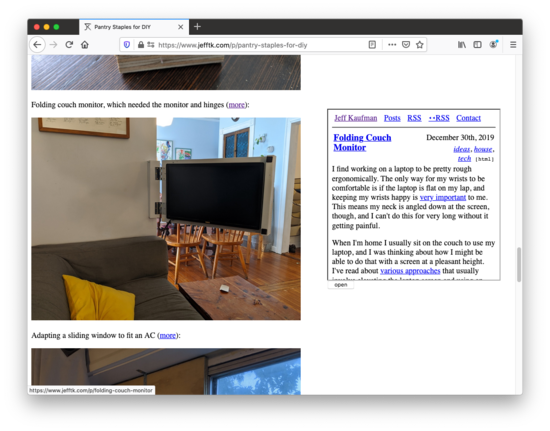A couple years ago, Wikipedia added a feature where if you hover over an internal link you'll see a preview of the target page:
Other sites with similar features include gwern.net:
And LessWrong:
In general, I like these features a lot. They dramatically lower the barrier the following internal links, letting you quickly figure out whether you're interested. On the other hand, they do get in the way. They pop up, overlapping the text you're reading, and mean you need to be paying more attention to where the mouse goes.
I decided I wanted to add a feature like this to my website, but without any overlap. The right margin seemed good, and if you're reading this on jefftk.com with a window at least 1000px wide then hovering over any link from one of my blog posts to another should show a preview:
Here are my five most recent posts if you'd like to give it a try:
- Coronavirus and Rents
- Second Wave?
- Keep: Move checked items to bottom
- Growing Independence
- Pantry Staples for DIY
There are a lot of options for how to implement this, but I decided to use an iframe that just loads the relevant page. Feel free to look at the page source and see exactly how it works, but the general idea is:
It loads the page directly, not a stripped down version like the examples above. My pages are simple enough that this is fine.
It's a preview, not a full page, so set
scrolling=no.It's a same-origin ("friendly") iframe, so I can reach into it and add a
clicklistener, so clicking on the iframe takes you through to the previewed post.I don't want comments, ads, analytics, or anything else potentially slow to run, and I don't use JS for rendering, so I use
sandboxto turn off JS.Once it's open it stays open until you hover a different preview.
It appears vertically aligned with the hovered link, and moves with the page out of view as you scroll down.
If you hover over a second link close to the first one, it reuses the same vertical position to avoid looking jumpy.
If you hover many links in quick succession it starts loading the first one immediately, and then discards any links that have been overtaken by events.
Comment via: facebook




It's very tricky to make it convenient for most, without losing accessibility for some. Preferences and device capabilities vary by a whole lot, and unless you're going to do the work to detect or ask people, and then support multiple mechanisms, you are probably best off being as close to minimal and standard as possible.
My primary mechanism for reading branching sites/articles (those with multiple topics I want to follow) is to open a lot of tabs, then work forward through them, opening more in the process. Hover is convenient to give me a quick idea of whether it's worth opening a tab, but it's really inconvenient if it stays too long or slows me down when I already know I want the tab.
LW goes a bit too far toward this, for me. It's fine on desktop, where I have lots of screen real-estate and the mouse click/focus works to dismiss the popups/hovers pretty well. It kind of annoys me when middle-click or control-click don't work to bring up a new tab (for shortforms or some comment-notice links), but that's tolerable. On Chrome on iOS, at least, it's _very_ annoying. in order to long-press to get the "open in new tab" option, it brings up a window that obscures a lot of other items, and there's no obvious way on the small screen to dismiss the "hover" without changing the underlying view in some way.